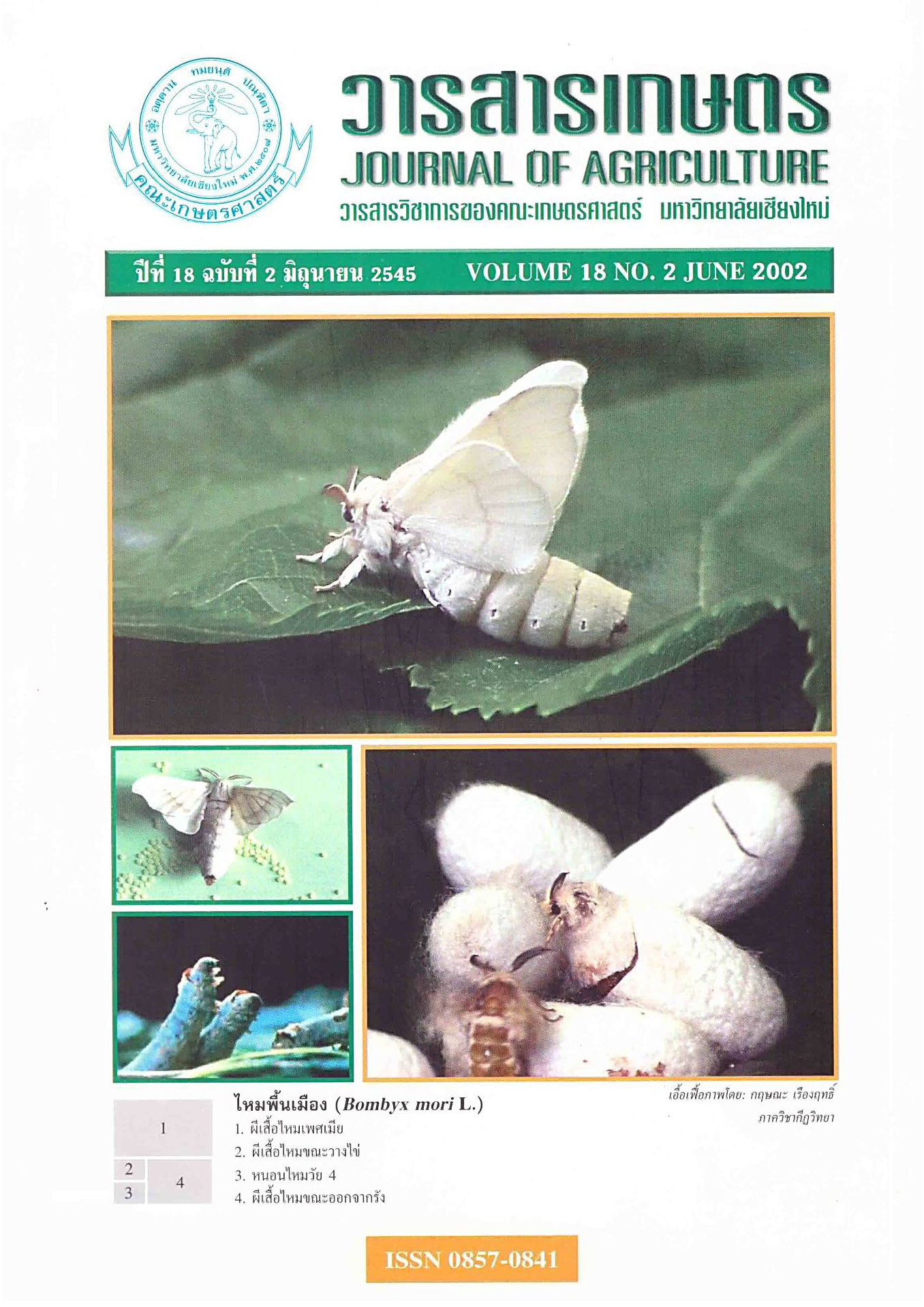ผลของพันธุ์ที่แตกต่างกันต่อปริมาณธาตุอาหารในใบมะกอกน้ำมัน
Main Article Content
บทคัดย่อ
ปลูกมะกอกน้ำมันซึ่งรวบรวมพันธุ์จากประเทศสเปน อิตาลี และอิสราเอล จำนวน 18 พันธุ์ ณ สถานีทดลองเกษตรที่สูงภูเรือ อ.ภูเรือ จ.เลย (927 m asl, 17° 17ˊN 101°24ˊE) เพื่อศึกษาอิทธิพลของพันธุ์มะกอกน้ำมันต่อปริมาณธาตุอาหารในใบ ในช่วงฤดูหนาว (เดือนธันวาคม 2544 ถึงกุมภาพันธ์ 2545) วัดปริมาณธาตุอาหารหลัก (N, P, K, Ca, และ Mg) และธาตุอาหารรอง (Fe, Mn, Zn และ Cu) ในใบมะกอกน้ำมันทั้ง 18 พันธุ์ ผลการทดลองพบว่า ปริมาณธาตุอาหารหลักในใบมะกอกน้ำมันประกอบด้วย N อยู่ในช่วง 1.708-2.418%, P 0.116-0.226%, K 0.415-0.763%, Ca 0.403-1.000%, Mg 0.071-0.145%, และปริมาณธาตุอาหารรอง ได้แก่ Fe 67.40-175.34 ppm, Mn 57.25-117.91 ppm, Zn 12.67-29.52 ppm และ Cu 5.88-66.74 ppm ปริมาณธาตุอาหารในใบระหว่างมะกอกน้ำมันทั้ง 18 พันธุ์ มีความแตกต่างกันทางสถิติ (p ≤ 0.01) โดยที่พันธุ์ ‘Arbequina’ มีปริมาณ N, P และ Cu ในใบสูงที่สุด ซึ่งเป็นพันธุ์ที่มีการเจริญเติบโตค่อนข้างดี และสามารถออกดอกติดผลได้ในประเทศไทย, พันธุ์ ‘Gordal’ มีปริมาณ Ca และ Mn ในใบสูงที่สุด ขณะที่พันธุ์ ‘Nocellare-Messinese Coratina’, ‘Barnea’ และ ‘Carolea’ มีปริมาณ K, Mg, Zn และ Fe ในใบสูงที่สุดตามลำดับ
Article Details
เอกสารอ้างอิง
ศรปราญ์ ธไนศวรรยางกูร. 2539. ว่าด้วยความรู้เรื่องมะกอก (Olive, Olea europaea L.) ในแถบทะเลเมดิเตอร์เรเนียน. ภาควิชาพฤกษศาสตร์ คณะวิทยาศาสตร์ มหาวิทยาลัยเกษตรศาสตร์. กรุงเทพฯ. 105 หน้า.
ศรีสม สุวรรณวงค์. 2544. การวิเคราะห์ธาตุอาหารพืชพิมพ์ครั้งที่ 1. สำนักพิมพ์มหาวิทยาลัยเกษตรศาสตร์. กรุงเทพฯ. 141 หน้า.
เสริมสกุล พจนการุณ และดิเรก ตนพยอม. 2545. การรวบรวมและศึกษาพันธุ์มะกอกน้ำมัน : การเจริญเติบโตและการออกดอกติดผลของมะกอกน้ำมัน. ใน: เอกสารประกอบการประชุมวิชาการพืช สวนแห่งชาติครั้งที่ 2 ภาคบรรยาย ระหว่างวันที่ 28-30 พฤษภาคม 2545. หน้า 66.
Benton-Jones, J. 1971. The Proper Way to Take a Plant Sample for Tissue Analysis. pp. 15-18. In: Soil and Crops. Am. Soc. Agron. Publ.
Chapman, H.D. 1971. Tissue Testing : Current Status. In: Proc. Int. Symp. Soil Fert. Evaluat., New Delhi, 1: 165-197.
Dimassi, K., I. Therios and A. Passalis. 1999. Genotypic Effect on Leaf Mineral Levels of 17 Olive Cultivars Grown in Greece. Acta Hort. 474: 345-348.
Fernandez. A.G., M.J. Fernandez Diez and M.R.Adams.1997. Table Olives: Production and processing. Chapman & Hall.London.495p.
Fernãndez-Escobar, R., R. Morene and M.Garcia.-Creus. 1999.Seasonal Changes of Mineral Nutrients in Olive Leaves During the Alternate-Bearing Cycle. Scientia Hortic. 82: 25-45.
Jordão, P.V., M.E. Marcelo and M.S.L. Centeno. 1999. Effect of Cultivar on Leaf-Mineral Composition of Olive Tree. Acta Hort. 474:349-352.
Kohli, R.R., L. Ram, A.D. Huchche, A.K, Srivastava and H.C. Dass. 1992. Survey of Mandarin Orchards in Vidarbha region of Maharashtra for Leaf and Soil Nutrient Status. Ann. Report., (1992-93), NRC for Citrus, Nagpur. pp. 18-19.
Manzel, C.M., G.F. Haydon and D.R. Simpson. 1992. Mineral Nutrient Reserves in Bearing Litchi Trees (Litchi chinensis Sonn.). J. Hort. Sci. 67: 149-160.
Mills, H.A. and J.B. Jones. 1996. Plant Analysis Handbook II. Micromacro Publishing Georgia. 422 p.
Ram, L., R.R. Kohli, A.K. Srivastava, A.D. Huchche and H.C. Dass. 1997. Nutritional Requirement of Nagpur Mandarin (Citrus reticulata Bianco) Grown on Vertisol in Central India. Indian J. 7Hort. 54 (2): 91-97.
Renowden, G. 1999. The Olive Book. Canterbury University Press. Canterbury. 146p.
Sher, C.B. and M. Faust. 1980. Nutritional Ranges in Deciduous Tree Fruits and Nuts. Hortic. Rev. 146-163.
Srivastava, A.K., R.R. Kohli, H.C. Dass, L. Ram and A.D. Huchche. 1995. Relationship of Leaf K with N Status of Nagpur Mandarin Orchards. Indian J. Hort. 52(4): 234-238.
Tattini, M., P. Mariotti and P. Fiorino. 1986. Fertirrigazione, Crescita ed Analisi Fogliare di Piante di Olivo Autoradicate (cv. Frangivento) Allevate in Contenitore. Riv. Ortoflorofrutt.It. 70: 439.
Tserling, V.V. 1976. Mineral Plant Nutrition in Development Phases in Relation to Yield Structure Components. 4th Int. Collog. in The Control of Plant Nutrition. Gent. 1: 10-19.


